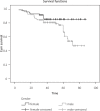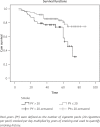Early lung cancer in the elderly: sublobar resection provides equivalent long-term survival in comparison with lobectomy
- PMID: 24966794
- PMCID: PMC4068813
- DOI: 10.5114/wo.2014.42726
Early lung cancer in the elderly: sublobar resection provides equivalent long-term survival in comparison with lobectomy
Abstract
Aim of the study: The worldwide population shift towards older ages will inevitably lead to more elderly patients being diagnosed with non-small cell lung cancer (NSCLC). It still remains controversial whether sublobar resection is effective in such cases at an early stage. To answer this question, we need to understand the clinical characteristics of these tumors.
Material and methods: From 2004 to 2010, a total of 167 patients with stage I non-small cell lung cancer (NSCLC) of age ≥ 70 years underwent complete resection in our institution. The clinical data were retrospectively analyzed as regards gender, stage of disease, histology, smoking status, smoking amount, drinking status, surgical approaches and overall survival. Survival was analyzed by the Kaplan-Meier method and log-rank test.
Results: The overall 5-year survival rate was 62.4%. There were 122 (73.1%) patients who underwent standard lobectomy resection and 45 (26.9%) patients underwent sublobar resection. Patients with different surgical approaches (lobectomy and sublobar resection) had nearly the same 5-year survival rate (60.9% vs. 63.4%, p = 0.558). Gender (p = 0.023), smoking status (p = 0.045) and smoking amount (p = 0.007) significantly influenced the prognosis.
Conclusions: In elderly stage I NSCLC patients, sublobar resection is considered to be an appropriate treatment in comparison with lobectomy, as this procedure provides equivalent long-term survival.
Keywords: elderly; non-small cell lung cancer (NSCLC); sublobar resection; surgical resection.
Figures
References
-
- Pirozynski M. 100 years of lung cancer. Respir Med. 2006;100:2073–84. - PubMed
-
- Crinò L, Weder W, van Meerbeeck J, Felip E. Early stage and locally advanced (non-metastatic) non-small-cell lung cancer: ESMO Clinical Practice Guidelines for diagnosis, treatment and follow-up. Ann Oncol. 2010;21(Suppl 5):v103–v115. - PubMed
-
- Scott WJ, Howington J, Feigenberg S, Movsas B, Pisters K. American College of Chest Physicians. Treatment of non-small cell lung cancer stage I and stage II: ACCP evidence-based clinical practice guidelines. Chest. (2nd edition) 2007;132(3 Suppl):234S–42S. - PubMed
-
- Okami J, Ito Y, Higashiyama M, Nakayama T, Tokunaga T, Maeda J, Kodama K. Sublobar resection provides an equivalent survival after lobectomy in elderly patients with early lung cancer. Ann Thorac Surg. 2010;90:1651–6. - PubMed
-
- Goldstraw P, Crowley J, Chansky K, et al. The IASLC Lung Cancer Staging Project: proposals for the revision of the TNM stage groupings in the forthcoming (seventh) edition of the TNM classification of malignant tumours. J Thorac Oncol. 2007;2:706–14. - PubMed
LinkOut - more resources
Full Text Sources
Other Literature Sources
Research Materials



